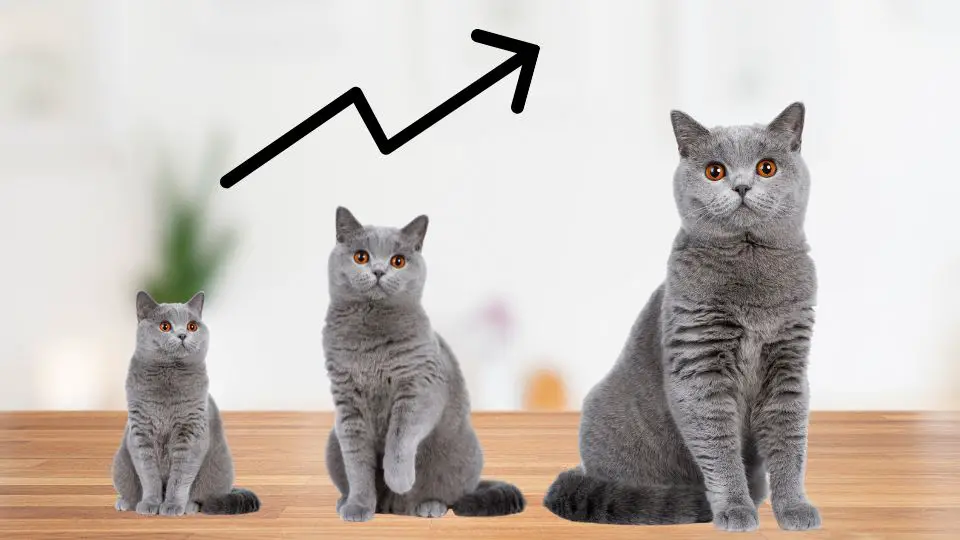Dealing with a sensitive stomach in your beloved British Shorthair can be a challenging experience.
Digestive issues can cause discomfort and affect their overall well-being. However, with the right strategies and care, you can effectively manage their sensitive stomach and help them lead a happy, healthy life.
In this article, we will provide you with valuable tips and insights to assist you in managing a sensitive stomach in your British Shorthair.
Signs of a sensitive stomach in British Shorthairs
British Shorthairs, like any other cats, can sometimes experience digestive issues and have a sensitive stomach. It’s important for cat owners to be aware of the signs that may indicate a sensitive stomach in their furry companions. Here are some common signs to watch out for:
Frequent vomiting or regurgitation
- British Shorthairs with a sensitive stomach may vomit or regurgitate their food frequently.
- This can occur shortly after meals or even hours later.
- Vomiting may be accompanied by undigested food or bile.
Diarrhea or loose stools
- Cats with sensitive stomachs may experience diarrhea or have loose, watery stools.
- This can result in more frequent litter box visits and messy clean-ups.
- Diarrhea may be intermittent or chronic, depending on the underlying cause.
Flatulence or excessive gas
- If your British Shorthair frequently passes gas or has a gassy odor, it may indicate a sensitive stomach.
- Flatulence can be accompanied by discomfort or bloating in some cats.
- Excessive gas may be caused by certain foods that are not well-tolerated by their digestive system.
Dietary considerations
British Shorthairs with sensitive stomachs require special dietary considerations to help alleviate their digestive issues. Here are some important dietary tips to keep in mind:
Choose a high-quality, easily digestible cat food
- Opt for cat food that is specifically formulated for sensitive stomachs.
- Look for easily digestible ingredients, such as lean proteins and easily digestible carbohydrates.
- Avoid foods that contain artificial additives, preservatives, or fillers that may irritate the stomach.
Consider limited ingredient
- Limited ingredient diets consist of a smaller number of ingredients, making it easier to identify and avoid potential allergens.
- Hypoallergenic diets are specially formulated to minimize the risk of triggering allergic reactions.
- These diets often feature novel protein sources and easily digestible carbohydrates.
Avoid common food allergens or irritants
- Some common food allergens for cats include poultry, beef, dairy, and grains.
- Consider eliminating these potential allergens from your cat’s diet to see if their sensitive stomach improves.
- Gradually introduce new foods and closely monitor your cat’s reaction to identify any specific triggers.
Feed smaller, more frequent meals
If your British Shorthair has a sensitive stomach, one helpful strategy is to feed smaller, more frequent meals. Here’s why and how to implement this feeding approach:
Divide meals into smaller portions throughout the day:
- Instead of feeding your cat two larger meals, divide their daily food allowance into several smaller meals.
- This can help reduce the strain on their digestive system, allowing for better digestion and absorption of nutrients.
- Smaller meals also minimize the risk of overeating, which can lead to gastrointestinal discomfort.
Avoid overfeeding or large meals:
- Overfeeding can overwhelm a sensitive stomach, causing digestive issues like vomiting or diarrhea.
- Follow the recommended feeding guidelines provided by your veterinarian or the cat food manufacturer to ensure proper portion control.
- Use a measuring cup to accurately measure the amount of food your cat needs for each meal.
By feeding smaller, more frequent meals, you provide your British Shorthair with a sensitive stomach with a consistent and manageable amount of food throughout the day. This approach allows their digestive system to process the food more efficiently and can help prevent digestive upset.
Slowly introduce new foods or treats
As a general rule, it’s essential to slowly introduce new ingredients to your cat’s diet, especially if they have a sensitive stomach. Sudden changes in diet can be disruptive to their digestive system and may trigger gastrointestinal issues such as vomiting or diarrhea. By introducing new foods or treats gradually, you can closely monitor their reactions and make adjustments as needed.
Here’s how to go about it:
- Start with a small portion: Begin by offering a tiny amount of the new food or treat, mixed with their regular food. This allows your cat’s digestive system to gradually adapt to the new ingredient.
- Observe for any adverse reactions: Pay close attention to your cat’s response to the new ingredient. Monitor for signs of digestive upset, such as vomiting, diarrhea, or changes in appetite.
- Increase the quantity slowly: If your cat tolerates the new food well, gradually increase the amount over several days or weeks. This gradual approach allows their digestive system to adjust without overwhelming it.
- Monitor long-term effects: Even if the initial introduction goes smoothly, continue to monitor your cat’s reaction to the new ingredient over a longer period. Sometimes, sensitivities or allergies may develop over time, so it’s important to remain vigilant.
Remember, every cat is unique, and their sensitivity to certain ingredients may vary. What works well for one cat may not work for another. By introducing new foods or treats slowly and monitoring their response, you can identify any potential triggers or sensitivities and make informed decisions about their diet.
Consult with a veterinarian
When your British Shorthair is experiencing digestive issues or a sensitive stomach, it’s crucial to consult with a veterinarian for professional guidance and diagnosis. Here’s why and what you can expect during a veterinary consultation:
- Seek professional guidance: Veterinarians are trained to diagnose and treat various health conditions in cats, including digestive issues. By seeking their expertise, you can gain valuable insights into the underlying causes of your British Shorthair’s sensitive stomach and receive appropriate recommendations for managing it.
- Rule out underlying medical conditions: There could be underlying medical conditions contributing to your cat’s digestive issues. A veterinarian will conduct a thorough examination, review your cat’s medical history, and may recommend additional tests or diagnostic procedures to rule out any underlying health problems. Identifying and addressing these conditions is crucial for effective management.
- Discuss appropriate treatment options: Based on their assessment, the veterinarian will discuss suitable treatment options for your British Shorthair’s sensitive stomach. This may include dietary modifications, specific medications, or other interventions tailored to your cat’s individual needs. They will explain the benefits and potential side effects of each treatment option, allowing you to make informed decisions about your cat’s care.
During the consultation, be prepared to provide detailed information about your cat’s symptoms, including the frequency and duration of any digestive issues. The veterinarian may also ask about your cat’s diet, lifestyle, and any recent changes that could be contributing to the sensitivity.
Provide a calm and stress-free environment
Creating a calm and stress-free environment is crucial when managing a sensitive stomach in your British Shorthair. Here are some tips on how to provide a peaceful atmosphere for your cat:
Minimize stressful situations or triggers
Cats are sensitive creatures, and stress can exacerbate digestive issues. Identify potential stressors in your cat’s environment and take steps to minimize or eliminate them. This may include reducing loud noises, maintaining a consistent daily routine, and providing hiding spots or safe areas where your cat can retreat when feeling anxious.
Create a quiet feeding area
Designate a quiet and calm space for your British Shorthair’s mealtimes. This area should be free from disturbances and distractions. Consider placing the food bowl in a secluded corner or a separate room where your cat can eat without feeling rushed or anxious. Providing a peaceful feeding environment can help your cat relax and focus on their meal.
Maintain a routine
Cats thrive on routine and predictability. Establish a consistent feeding schedule and stick to it as closely as possible. Regular mealtimes can help regulate your cat’s digestive system and reduce the likelihood of stomach upset. Additionally, maintaining a consistent routine for other daily activities, such as playtime and rest, can contribute to overall well-being and help minimize stress.
Provide comfort and reassurance
Cats often find comfort in familiar scents and objects. Consider placing a soft blanket or bedding near their feeding area to create a sense of security. You can also offer gentle strokes and soothing words during and after meals to provide reassurance and help your cat feel more relaxed.
Monitor and track your cat’s diet and symptoms
Here are some tips on how to effectively monitor and track your cat’s diet and symptoms:
Keep a food diary
Maintain a detailed record of the food your cat consumes. Include information such as the brand and type of cat food, specific ingredients, and portion sizes. Additionally, note any treats or table scraps that your cat receives. By keeping a food diary, you can identify potential triggers or patterns in your cat’s diet that may be causing digestive issues.
Note changes in behavior
Pay close attention to any changes in your cat’s behavior or demeanor. Watch for signs of discomfort, such as excessive grooming, restlessness, or avoiding the food bowl. Also, observe their litter box habits for any changes in stool consistency or frequency. By noting these behavioral changes, you can better understand how your cat’s digestive system is responding to their diet.
Record digestive issues
If your cat experiences vomiting, diarrhea, or other digestive problems, make sure to record the details. Note the frequency, duration, and severity of these symptoms. This information can be valuable when discussing your cat’s condition with a veterinarian and can help identify potential triggers or underlying causes of the sensitive stomach.
Make gradual changes
Again, if you decide to make any changes to your cat’s diet, do so gradually. Sudden dietary changes can upset their digestive system and worsen sensitive stomach symptoms. Instead, introduce new foods or dietary modifications slowly over a period of several days or weeks, allowing your cat’s system to adjust and minimize the risk of gastrointestinal upset.
Wrapping up
By implementing these tips and being proactive in managing your British Shorthair’s sensitive stomach, you can help alleviate their discomfort and promote their overall digestive health. Remember to consult with your veterinarian for personalized advice and guidance, as they can provide tailored recommendations based on your cat’s individual needs.
With patience, a careful diet, and a stress-free environment, you can help your British Shorthair enjoy a comfortable and fulfilling life, free from digestive troubles.







